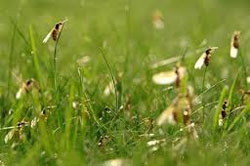The presence of winged ants in the home causes much consternation among homeowners. These intrusions are not cause for concern and are the result of a harvester ant behavior called “hill topping”.
What are flying ants?
Harvester ants (Pogonomyrmex sp.) are a common species that form large mounds of sand or small pebbles. They are seed feeders and do not feed on sugar or grease foods in the home. They enter the home inadvertently during the mating process. Males and females congregate around tall objects such as trees, chimneys or building vents. Sometimes, thousands of winged ants will fall into vents or chimneys. Mating swarms are usually associated with a recent rainfall.
foods in the home. They enter the home inadvertently during the mating process. Males and females congregate around tall objects such as trees, chimneys or building vents. Sometimes, thousands of winged ants will fall into vents or chimneys. Mating swarms are usually associated with a recent rainfall.
Are they harmful?
Harvester ant swarming lasts only for a short time. In a few days the males die. The mated females try to establish a new colony and are rarely successful. None of the ants will nest in the home. They do have a stinger but it is usually not able to penetrate most parts of the skin. Excluding swarms by screening your roof openings may be beneficial for this recurring problem.



